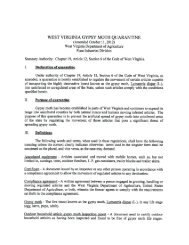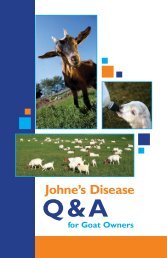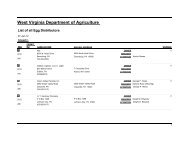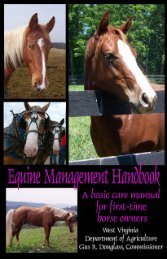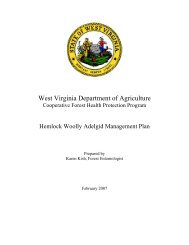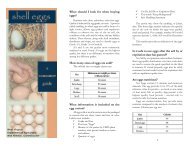Growing Grapes in WV - West Virginia Department of Agriculture
Growing Grapes in WV - West Virginia Department of Agriculture
Growing Grapes in WV - West Virginia Department of Agriculture
Create successful ePaper yourself
Turn your PDF publications into a flip-book with our unique Google optimized e-Paper software.
for fill<strong>in</strong>g <strong>in</strong> vacancies <strong>in</strong> anestablished v<strong>in</strong>eyard. Graft<strong>in</strong>g ispracticed chiefly by nurseries toestablish a cultivar on a differentrootstock and will not be describedhere.In layer<strong>in</strong>g varieties that donot root readily, a narrow trenchabout 10-15 <strong>in</strong>ches deep is dug<strong>in</strong> early spr<strong>in</strong>g where the newplant is desired or where there isroom to produce a nursery plant.A healthy cane <strong>of</strong> the previousseason’s growth, orig<strong>in</strong>at<strong>in</strong>gclose to the ground on aneighbor<strong>in</strong>g v<strong>in</strong>e is bent downto the bottom <strong>of</strong> the trench andvertically back up to br<strong>in</strong>g twoor more tip buds above the soilsurface. Wound<strong>in</strong>g the caneopposite each underground budwill hasten root<strong>in</strong>g. The trench isthen filled to promote root<strong>in</strong>g <strong>of</strong>the cane section below ground.The part <strong>of</strong> the cane connect<strong>in</strong>gthe new plant to the mother plantshould be stripped <strong>of</strong> develop<strong>in</strong>gshoots as they emerge. Onlythe shoots from the buds <strong>of</strong> theprotrud<strong>in</strong>g cane tip should be allowedto grow. The rooted plantscan be severed from the parentv<strong>in</strong>e the follow<strong>in</strong>g spr<strong>in</strong>g and set<strong>in</strong> their permanent location. If therooted plant is to fill the vacancywhere it is rooted, the plantshould not be severed from themother plant until the diameter <strong>of</strong>the new v<strong>in</strong>e trunk exceeds thediameter <strong>of</strong> the bent over caneand fruit should be removed forthe first two years.Rootstocks<strong>Grapes</strong> can be grown on theirown roots or grafted onto a plantthat provides special root characteristics.The primary reasons forus<strong>in</strong>g a rootstock are to provideresistance to phylloxera andnematode parasites on the rootsystem, to isolate the scion cultivarfrom soilborne virus diseases,to <strong>in</strong>duce vigorous growth <strong>in</strong> areplant situation, and to avoidvarietal susceptibility to lime<strong>in</strong>ducedchlorosis. If any <strong>of</strong> thesesituations apply to the plannedv<strong>in</strong>eyard site, rootstocks shouldbe considered.CultivarsGrape cultivars tested <strong>in</strong><strong>West</strong> Virg<strong>in</strong>ia are listed <strong>in</strong> Table3 pages 24-27. Because <strong>of</strong>the diversity <strong>of</strong> climate <strong>in</strong> <strong>West</strong>Virg<strong>in</strong>ia, it is suggested that anycultivar to be planted should betried on a trial basis first. Inclusion<strong>in</strong> this table is not an <strong>in</strong>dicationthat the plants will survive <strong>in</strong>all locations.-6-





